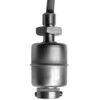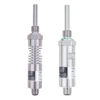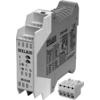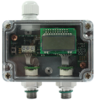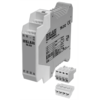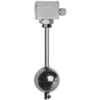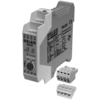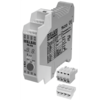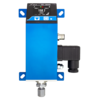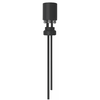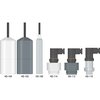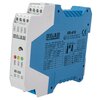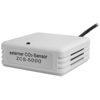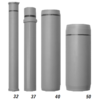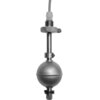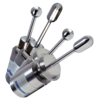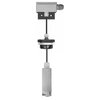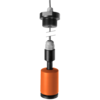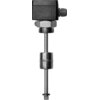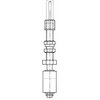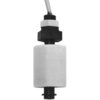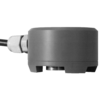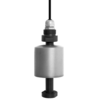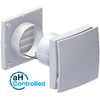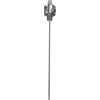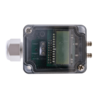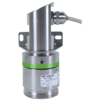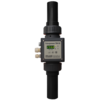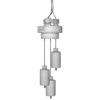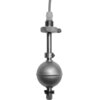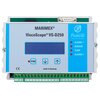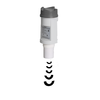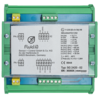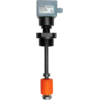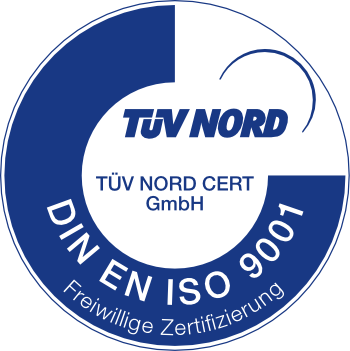Cart
TSR-CAN-03 configure
PVG-399 configure
ER-214 configure
TK-312 configure
TK-315 configure
TK-313 configure
ES-22 configure
NP-256 configure
XR-4x0 | XR-4x1 configure
PPS-390 configure
ES-21 configure
ViscoScope® VA-100 configure
ELH 24 V configure
T-200.L configure
MKL configure
EP 24V configure
EE-24 configure
ZMF-203e-IR configure
TRM-100 configure
HE configure
VS-D250 configure
LU-150 configure
T-200.F Ex configure
T205-0
Immersible Magnetic Probe made of PVC, PE, PPH, PTFE or stainless steel (1.4571)
Magnetic immersion probes for use with highly aggressive liquid media for detecting level limits in containers
Properties
- Protection class : IP 68 Kabel
- Float type : max. 4x Zylinder Edelstahl 27 mm Ø
- connection cable : 1000 mm PUR Blau
- Sliding tube length : max. 6000 mm
- Operating temperature : max. 120 °C
- Operating pressure : max. 10 bar (Schwimmer)
- media density : 0,78 g/cm³
- Number of contacts : max. 2 Schließer / 2 Öffner
- Switching current : 1A, 2A
- Switching capacity : 50 W/VA
- min. contact distance with several floats : 50 mm
TSR-CAN-03
CANopen transmitter for temperature measurement in media
High-quality stainless steel transmitter for precise temperature measurement in all stainless steel-compatible media
Measurement parameters
- Measuring range : -40…+80 °C (optional +150°C)
- deviation : ± 0,3 K (-40…+80 °C)
- Measuring element : Halbleiter
- measuring resolution : 10 Bit
- measuring grid : ab 5 ms
ElectricalConnection
- CAN protocol : CANopen 2.0 A, nach ciA DS 404
- Physical Layer : nach DIN 11898
- Operating voltage : 12…27 V ±20 %
Operating conditions
- Operating temperature : -40...+80 °C
- Storage temperature : -40°C...+120°C
- Shock resistance : 30g, Dauer: 14 ms bei Raumtemperatur
- Vibration resistance : 10g bei 20 bis 1000 Hz
PVG-399
PVC weight with magnet insert and eyelet for cable fixing
for actuating monostable and bistable contacts
Variants
- 32 : Außen Ø 25 mm x 175 mm, Gewicht ca. 180 g, geeignet für Rohraußen Ø 32 u. 34 mm bis 6m Länge
- 37 : Außen Ø 30 mm x 170 mm, Gewicht ca. 180 g, geeignet für Rohraußen Ø 40 mm bis 6m Länge
- 40 : Außen Ø 40 mm x 110 mm ca. 175g, geeignet für Rohraußen Ø 50 mm bis 6m Länge
- 4012 : Außen Ø 40 mm x 110 mm ca. 300g, geeignet für Rohraußen Ø 50 mm bis 12m Länge
- 4016 : Außen Ø 40 mm x 110 mm ca. 360g geeignet für Rohraußen Ø 50 mm bis 16m Länge
- 50 : Außen Ø 50 mm x 130 mm ca. 255g, geeignet für Rohraußen Ø 63 mm bis 6m Länge
- 5012 : Außen Ø 50 mm x 130 mm ca. 300g geeignet für Rohraußen Ø 63 mm bis 12m Länge
- 5016 : Außen Ø 50 mm x 130 mm, ca. 360g, geeignet für Rohraußen Ø 63 mm bis 16m Länge
ER-214
Electrode Relays
Electrode relays for conductive level detection for all areas in which conductive, liquid media are to be detected, controlled or monitored
Properties
- Protection class EN60529 clamp : IP 20
- Protection class EN60529 front panel housing : IP 40
- Operating temperature : –20...+60 °C
- Storage temperature : –30...+80 °C
- AC nominal frequency : 48...62 Hz
- Power consumption : max. 1 W / VA
- Weight : ca. 150 g
Input
- Open circuit voltage : ≤ 10 V AC
- Short-circuit current : ≤ 5 mA
Output
- Contacts : 1 potentialfreie Wechselkontakte pro Kanal
- Switching voltage : min. 5 V | max. 250 V AC | max. 150 V DC
- Switching current : min. 5 mA | max. cosφ=1 3A | max. cosφ=0,7 1 A/AC | max. cosφ=1
- Switching capacity : min. 300 mW | max. 750 VA / 150 W (30 V DC / 5 A) / 18 W (150 V DC / 0,12 A)
- Working / Idle current : umschaltbar
- overvoltage category : EN 61010-1 Kategorie III
ZDT-H
Differential pressure transmitter for high pressure applications
Versatile and reliable differential pressure transmitter for measuring air, non-aggressive media as well as liquids and oils.
Properties
- Pressure type : Differenzdruck
- Housing : Kunststoff mit LCD-Anzeige (oponal)
- Overpressure : 1,2* (1,5*) x Nenndruck
Measurement parameters
- Total error : ± 2,5 % FS (typ. ± 0,5 %)
- Linearity error : ± 1 % FS
- Signal output selection : 0...10 V 4...20 mA, 2-Leiter 4...20 mA, 3-Leiter
- Pressure range : 5…1.000 bar
Operating conditions
- Operating voltage : 14...28 VDC ± 10 %
- Operating temperature : 0...+50 °C
- Storage temperature : -20°C...+120°C
Connections
- Electrical connection : Schraubklemme im Gehäuse
- Process connection : G1/4" (andere auf Anfrage)
TK-312
Evaluation unit with 0/4... 20 mA current output
The TK-312 measuring transducer converts the resistance signal supplied from a continuous level sensor into a current signal proportionate to the level.
Properties
- Protection class EN60529 clamp : IP 20
- Protection class EN60529 front panel housing : IP 40
- Operating temperature : –20...+60 °C
- nominal voltage : 24... 230 V AC/DC
- Power consumption : 2 VA, 2W
- Dimensions housing type B : 22,5 x 114,5 x 99
- Dimensions housing type C : 22,5 x 114,5 x 114
Input
- Voltage : 0...10 V
- Resistance in three-wire circuit RG : 0-4...10 kW
Output
- Temperature influence tolerance : max. ± 0,6 % der Signalspanne
- Current output : 0/4... 20 mA bezogen auf die Masse des Eingangs
- Voltage output : 0/2... 10 V
- Mounting : Tragschiene nach EN 50022
- Weight : 175 g
T209
Immersible Magnetic Probe made of PVC, PE, PPH, PTFE or stainless steel (1.4571)
Magnetic immersion probes for use with highly aggressive liquid media for detecting level limits in containers
Properties
- connection : Polyesterdose | Aluminiumdose
- Protection class EN60529 : IP 65 Anschlussdose
- Connector plug : 3- und 6-fach
- connection thread : G 1/8" | G 3/8" | G 1/4" | G 1/2" | G 1" | G1 1/4" | G1 1/2" | G2" | G3"
- connection cable : LiYY max. 80 °C | PTFE-Litze, 0,24 mm² | Silikon max. 150 °C
- Sliding tube length : max. 1000 mm (Rohr Ø 8 mm) | 6000 mm
- Operating pressure : max. 20 bar
- Viscosity : < 100 cp
- Protection class EN60529 : IP 68 Führungsrohr
- Switching voltage : max. 250 V
- Switching hysteresis : ca. 2...5 mm
- Holding range : ca. 12 mm
- Contact function : monostabil | bistabil
Operating temperature
- ltdata. : max. +60...+150 °C
- ltdata. : min. –20... –10 °C
- ltdata. : höhere oder niedrigere Temperaturen auf Anfrage
Switching capacity
- Changeover contact : 60 W/VA
- normally open : 100 W/VA
- Normally closed contact : 60 W/VA
Switching current
- Changeover contact : max. 1 A
- NO/NC contact : max. 2 A
Contacts
- Changeover contact : 8
- normally open : 10
- Normally closed contact : 7
TK-315
Evaluation unit with 4 limit contacts (NO-contacts)
The TK-315 limit comparator can be used in conjunction with our TK-30... continuous level sensors with 0(4)...20 mA or 0...10 V output signal for level control/measurement.
Properties
- Protection class EN60529 clamp : IP 20
- Protection class EN60529 front panel housing : IP 40
- Operating temperature : –20...+60 °C
- nominal voltage : 24... 230 V AC/DC
- Power consumption : 2 VA
- Dimensions housing type B : 22,5 x 114,5 x 99 mm
- Dimensions housing type C : 22,5 x 114,5 x 114 mm
Input
- power : 0/4...20 mA
- Voltage : 0...10 V
- Resistance in three-wire circuit RG : 0–4...10 kΩ
Output
- Output contacts : 4 Schließerkontakte
- Switching voltage : max. 250 V AC
- Switching current : max. 3 A
- Switching capacity : max. 500 VA
- Temperature influence tolerance : max. ± 0,6 % der Signalspanne
- Mounting : Tragschiene nach EN 50022
- Current output : 4...20 mA bezogen auf die Masse des Eingangs
- Display (%) : 2-stellig, 7-Segment
- Weight : 175 g
TK-313
Evaluation unit with 2 change over limit contacts
The TK-313 limit comparator can be used in conjunction with our
TK-30... continuous level sensors with 0(4)...20 mA or 0...10 V output
signal for level control / measurement.
Properties
- Protection class EN60529 clamp : IP 20
- Protection class EN60529 front panel housing : IP 40
- Operating temperature : –20...+60 °C
- nominal voltage : 24... 230 V AC/DC
- Power consumption : 2 VA
- Dimensions housing type B : 22,5 x 114,5 x 99
- Dimensions housing type C : 22,5 x 114,5 x 114
Input
- power : 0/4...20 mA
- Voltage : 0...10 V
- Resistance in three-wire circuit RG : 0–4...10 kΩ
Output
- Output contacts : 2 Wechselkontakte
- Switching voltage : max. 250 V AC
- Switching current : max. 3 A
- Switching capacity : max. 500 VA
- Temperature influence tolerance : max. ± 0,6 % der Signalspanne
- Mounting : Tragschiene nach EN 50022
- Current output : 4...20 mA bezogen auf die Masse des Eingangs
- Display (%) : 2-stellig, 7-Segment
- Weight : 175 g
- ltdata. :
ES-22
electronic safety pressure limiter with 2 safety functions
TÜV-certified, type-tested electronic safety switching device (SIL2)
Properties
- Operating voltage : 16...32 V DC (max. 5,9 W)
- Dimensions : 150 x 60 x 42 mm (L x B x H)
- Housing : Aluminium (eloxiert)
- Protection class : IP65
Approvals
- DGRL 2014/68/EU Kat:IV : Baumustergeprüft gemäß Druckgeräterichtlinie
- DIN EN12263:1998 : Kälteanlagen und Wärmepumpen Sicherheitsschalteinrichtungen zur Druckbegrenzung -Anforderungen und Prüfungen; Kategorie IV
- DIN EN378:2020 : Kälteanlagen und Wärmepumpen - Sicherheitstechnische und umweltrelevante Anforderungen
- DIN EN61508:2011 : SIL2
Measuring ranges
- Measuring range relative pressure (nominal pressure) : -1…500 bar
- Measuring range differential pressure (nominal pressure) : 0…1 mbar - 0…1.000 mbar
- Setting accuracy (from nominal pressure) : 0,1 %
Operating conditions
- Pressure type : Relativdruck, Differenzdruck
- Temperature of the fluid : -40…+125 °C
- Ambient temperature : -20…+65 °C
- Parts in contact with media : Edelstahl
process connection
- Version relative pressure : G ¼“ Innengewinde
- Version differential pressure : G ⅛“ Innengewinde
- Adapter for process connection : 6mm; 8mm oder 10mm
electrical connection
- Analogue current output : 1x 4…20 mA
- Digital inputs/outputs : 2x Alarm oder 1x Alarm & 1x Fernentriegelung
Load capacity of the switching contacts DC (24V)
- DC1 : 16 A
- DC13 : 1,5A
Load capacity of the switching contacts AC (230V)
- AC1 : 16 A
- AC3 : 10 A
- AC15 : 7 A
NP-256
Level Switch - multiple 2...4 - pneumatic (hose)
very reliable and simple
sensors for scanning liquids, in
particular when used for overflow
protection. liquids can be
aggressive, sticky or highly contaminated
Properties
- Protection class EN60529 : IP 54
- connection thread : ab G2”
- Union nut : ab G2¾”
- Container connection flange : ab DN 25
- HoseØ : 13x2 mm
- Operating temperature : +60 °C
- medium temperatur : max. +60 °C
- Contact : Wechsler
- Switching capacity : 500 VA
- Switch-on point (Viton membrane) : 150 mm WS ±30 mm
- Switch-off point (MembraneViton) : 90 mm WS ±30 mm
Material
- Hose : PVC
- Screw fitting/grommet : PVC
- flange : PVC
- Connection head : PVC
Switching voltage
- silver : max. 250 V AC
- Gold : max. 24 V AC
Switching current
- silver : max. 6 A
- Gold : max. 100 mA
HD-1XX
Hydrostatic filling level measurement
Continuous and precise level measurement in unpressurised, open basins and tanks as well as underground applications such as shafts, wells and boreholes.
XR-4x0 | XR-4x1
Electrode relay with ATEX
The electrode relays are used for conductive level detection.
levels. The possible applications extend
areas where conductive, liquid media are to be detected, controlled
to be detected, controlled or regulated. Hereby
level detection (overflow / dry run) as well as minimum / maximum
as well as minimum / maximum controls can be realised.
Protection class EN60529
- clamp : IP20
- Housing : IP40
Technical Data
- Operating temperature : -20...+60 °C
- Storage temperature : -30...+80 °C
- Output contacts : potentialfrei
- Switching voltage : min. 5 V | max. 250 V AC / 150 V DC
- Switching current : min. 5 mA | max. 5 A AC / 5 A DC
- Switching capacity : min. 300 mW | max. 100 VA / 50 W
- Quiescent current : umschaltbar
- Weight : ca. 250 g
- CE marking : siehe Konformitätserklärung
- Ex-protection/IECEx : siehe Prüfbescheinigung
ZCS-5000
Self-contained CO2 sensor ZCS-5000 in small housing with warning horn
stand alone CO2 sensor for measuring and monitoring carbon dioxide concentration in ambient air.
Properties
- Housing : Kunststoff
- Power supply 24V : 24V DC | 230V
Measuring element and parameter
- Measuring principle : optisch, NDIR
- measuring grid : 2 sec.
- Accuracy : ± (50ppm+3% vom Messwert) im Bereich von 300…5.000ppm CO2
Operating conditions
- Operating temperature : 0…+50 °C
- Storage temperature : -30 °C…+75 °C
- Operating humidity : 0…85% rH (nicht kondensierend)
- Storage humidity : 0…85% rH (nicht kondensierend)
PPS-390
PPH float with magnet insert
for actuating monostable and bistable contacts
Variants
- 32 : AußenØ 26 x 180 mm, für RohraußenØ 32 u. 34 mm Gewicht ca. 38 g
- 37 : AußenØ 29,5 x 170 mm, für RohraußenØ 40 mm (PN 16) Gewicht ca. 62 g
- 40 : AußenØ 40 x 165 mm, für RohraußenØ 50 mm Gewicht ca. 145 g
- 50 : AußenØ 50 x 125 mm, für RohraußenØ 63 mm Gewicht ca. 156 g
ES-21
Electronic safety switching device with 1 safety function
TÜV-certified, type-tested electronic safety switching device (SIL2)
Properties
- Operating voltage : 16...32 V DC (max. 5,9 W)
- Dimensions : 150 x 60 x 42 mm (L x B x H)
- Housing : Aluminium (eloxiert)
- Protection class : IP65
Approvals
- DGRL 2014/68/EU Kat:IV : Baumustergeprüft gemäß Druckgeräterichtlinie
- DIN EN12263:1998 : Kälteanlagen und Wärmepumpen Sicherheitsschalteinrichtungen zur Druckbegrenzung -Anforderungen und Prüfungen; Kategorie IV
- DIN EN378:2020 : Kälteanlagen und Wärmepumpen - Sicherheitstechnische und umweltrelevante Anforderungen
- DIN EN61508:2011 : SIL2
Measuring ranges
- Measuring range relative pressure (nominal pressure) : -1…500 bar
- Measuring range differential pressure (nominal pressure) : 0…1 mbar - 0…1.000 mbar
- Setting accuracy (from nominal pressure) : 0,1 %
Operating conditions
- Pressure type : Relativdruck, Differenzdruck
- Temperature of the fluid : -40…+125 °C
- Ambient temperature : -20…+65 °C
- Parts in contact with media : Edelstahl
process connection
- Version relative pressure : G ¼“ Innengewinde
- Version differential pressure : G ⅛“ Innengewinde
- Adapter for process connection : 6mm; 8mm oder 10mm
electrical connection
- Analogue current output : 1x 4…20 mA
- Digital inputs/outputs : 2x Alarm oder 1x Alarm & 1x Fernentriegelung
Load capacity of the switching contacts DC (24V)
- DC1 : 16 A
- DC13 : 1,5A
Load capacity of the switching contacts AC (230V)
- AC1 : 16 A
- AC3 : 10 A
- AC15 : 7 A
T204-0.F
Immersible Magnetic Probe for Ex Zone 0 (Cat. 1)
The T20... magnetic immersion probes are used to detect fill level limits in containers for liquid media, where an explosive atmosphere of Zone 0 (Cat. 1) exists in the gas space above the liquid and an Ex-Zone 1 (Cat. 2) exists outside the container in the area of the junction box.
Properties
- connection : Kabel PUR blau
- Protection class : IP 68 Dose
- number of floats : max. 4x
- Operating temperature : max. 135 °C
- F-Contact : 1 / 12 kΩ
- Number of additional contacts : max. 3x Wechsler | 5x Schließer | 3x Öffner
- Switching current : 1 A, 2 A (nur mit Schirmung)
- Switching voltage : 230 V AC
Float
- Stainless steel ball 61 mm Ø : max. 20 bar | 0,65 g/cm³
- min. contact gap type 04 : 85 mm
Switching contacts and switching capacity
- Changeover contact : max. 3x | 60W/VA
- normally open : max. 5x | 100 W / VA
- Normally closed contact : max. 3x | 60 W/VA
ViscoScope® VA-100
Inline Viscometer
Maintenance-free inline viscosity sensor for precise and reliable real-time measurement of viscosity directly in the process.
Properties
- Material : 1.4571 / 1.4404 (316Ti / 316L)
- Protection class : IP65
- Process temperature : -10°C … +130°C | (integriertes Pt100 im Messfühler)
- max. process pressure : Vakuum ... 64 bar
- Process connections : NPT | M48 | Varivent® | Tri-Clamp
- Cable length sensor - transmitter : Max. 1.000 Meter
- max. flow velocity : 5 m / sec
- Ex approval : II 1/2G Ex ia IIC T6...T3 Ga/Gb | (optional)
Sensor types
- Sphere : VA-100B
- Cylinder : VA-100C
Repeatability
- VA-100B : ± 0,5% | ± 1 Digit
- VA-100C : ± 0,3% | ±1 Digit
Measuring ranges
- VA-100C : 0,1 - 2.500 mPa·s x g/cm³
- VA-100B : 10 - 25.000 mPa·s x g/cm³
Probe dimensions
- VA-100C : Ø 32 x 145 mm
- VA-100B : Ø 32 x 120 mm
installation positions
- Reservoir :
- tanks :
- Pipe :
- flow cell :
- Installation is position-independent :
ELH 24 V
Hanging electrode as leakage probe 24 V DC
The leakage probes of the type series ELH are approved by the "DIBt" for the monitoring of collecting chambers, collecting devices, inspection and filling shafts.
General data
- Protection class : IP 68
- Probe body material : PE, PVC, PPH, PVDF
- Diameter probe body : 15 mm, 25 mm, 40 mm
- Operating temperature : atmosphärisch
- Operating pressure : atmosphärisch
- Resistance value of line monitoring : 22 kΩ / 100 kΩ
Material
- Screw connection : PVDF
- Cable : TPK ( PVC Basis)
- on request : FEP (Teflon), PVC - blau
- cable length : auf Wunsch (Standard 3 m)
- Material Sensor rods : Edelstahl (1.4571), Hastelloy B, Hastelloy C, Titan, Tantal, Glas-Kohlestifte
T-200.L
Leakage probes with general building authority approval
The leakage probes T-200.L are approved by the "DIBt" on the basis of the "WasBauPVO" for the detection of leaked liquids hazardous to water.
Connection
- Box : Polyesterdose (PO)
- Box : Polyethylen-Anschlusskopf (PE)
- Cable : Kabel (TPK)
- Plug : Stecker (ST)
Properties
- Protection class : IP 65
- Cable entry : PVDF-Verschraubung , PVC-Dichtung
- Material Float : PE
- Material leakage probe base : PE
- Cable : TPK (PVC Basis)
- Operating temperature : atmosphärisch
- Operating pressure : atmosphärisch
- media density : mit Schwimmer PE 52 ρ ≥ 1,05 g/cm³
- Switching hysteresis : typ. 2 mm
- Switching point tolerance : max. 2 mm
Resistance value
- Operational readiness : ca. 1 kΩ
- Leakage detection : ca. 12 kΩ
T204.F
Immersible Magnetic Probes Ex area zone 0 (Cat 1)
Properties
- connection : Polyester Dose | Aluminium Dose
- Protection class : IP 65 Dose
- number of floats : max. 4x
- Operating temperature : max. 135 °C
- F-Contact : 1 / 12 kΩ
- Number of additional contacts : max. 3x Wechsler | 5x Schließer | 3x Öffner
- Switching current : 1 A, 2 A (nur mit Schirmung)
- Switching voltage : 230 V AC
Float
- Stainless steel ball 52mm Ø : max. 20 bar | 0,75 g/cm³
- Stainless steel ball 61 mm Ø : max. 20 bar | 0,65 g/cm³
- Stainless steel cylinder 44 mm Ø : max. 15 bar | 0,76 g/cm³
- min. contact gap type 03 : 75 mm
- min. contact gap type 04 : 85 mm
- min. contact gap type 09 : 75 mm
Switching contacts and switching capacity
- Changeover contact : max. 3x | 60W/VA
- normally open : max. 5x | 100 W / VA
- Normally closed contact : max. 3x | 60 W/VA
T207
Magnetic immersion probes made of PPH
Magnetic immersion probes for use with highly aggressive liquid media for detecting level limits in containers
Properties
- connection : Polyesterdose | Aluminiumdose
- Protection class EN60529 : IP 65 Anschlussdose
- Connector plug : 3- und 6-fach
- connection thread : G 1/8" | G 3/8" | G 1/4" | G 1/2" | G 1" | G1 1/4" | G1 1/2" | G2" | G3"
- connection cable : LiYY max. 80 °C | PTFE-Litze, 0,24 mm² | Silikon max. 150 °C
- Sliding tube length : max. 1000 mm (Rohr Ø 8 mm) | 6000 mm
- Operating pressure : max. 20 bar
- Viscosity : < 100 cp
- Protection class EN60529 : IP 68 Führungsrohr
- Switching voltage : max. 250 V
- Switching hysteresis : ca. 2...5 mm
- Holding range : ca. 12 mm
- Contact function : monostabil | bistabil
Operating temperature
- ltdata. : max. +60...+150 °C
- ltdata. : min. –20... –10 °C
- ltdata. : höhere oder niedrigere Temperaturen auf Anfrage
Switching capacity
- Changeover contact : 60 W/VA
- normally open : 100 W/VA
- Normally closed contact : 60 W/VA
Switching current
- Changeover contact : max. 1 A
- NO/NC contact : max. 2 A
Contacts
- Changeover contact : 8
- normally open : 10
- Normally closed contact : 7
MKL
Magnetic Flap Indicator
The MKL level indicator is connected by its two connections to the container to be monitored (see connection example). According to the law of interconnected containers the level in the float chamber corresponds exactly to the level in the container
Properties
- connection : Flansch ab DN 15
- Material : rostfreier Edelstahl, PVC, PPH, PVDF
- Material flange : Edelstahl 1.4571, C22.8
- Material Float : Edelstahl, Titan, PVC, PPH, PVDF
- Number of contacts : beliebig
- Contact load : max 10 VA, max 230 V AC
- Display length : max. 6m
Operating temperature
- PTFE seal : max. 150 °C
- Stainless steel: Klingerit seal : max. 200 °C
- PVC : max. 60 °C
- PPH : max. 90 °C
- PVDF : max. 130 °C
Stainless steel float
- Weight : ~ 300 g
- Dimensions : Ø 52 x 270
- Operating pressure : 16 bar
- media density : ρ ≥ 0,70 g/cm³
Stainless steel float
- Weight : ~ 320 g
- Dimensions : Ø 52 x 270
- Operating pressure : 40 bar
- media density : ρ ≥ 0,75 g/cm³
Titanium float
- Weight : ~ 180 g
- Dimensions : Ø 52 x 150
- Operating pressure : 16 / 40 bar
- media density : ρ ≥ 0,73 g/cm³
PVC float
- Weight : ~ 331 g
- Dimensions : Ø 52 x 250
- Operating pressure : 6 bar
- media density : ρ ≥ 0,8 g/cm³
PPH float
- Weight : ~ 283 g
- Dimensions : Ø 52 x 250
- Operating pressure : 6 bar
- media density : ρ ≥ 0,69 g/cm³
PVDF float
- Weight : ~ 352 g
- Dimensions : Ø 52 x 250
- Operating pressure : 6 bar
- media density : ρ ≥ 0,85 g/cm³
T205 PP
Magnetic immersion probes made of PP
Magnetic immersion probes for use with highly aggressive liquid media for detecting level limits in containers
Properties
- Protection class : IP 65
- Number of floats : 1x Typ 12 | 1x Typ 13
- connection cable : LiYY-Kabel 0,14 mm² | PVC-Litze 0,24 mm²
- Operating temperature : max. 60 °C
- Operating pressure : drucklos
- Number of contacts : 1x Schließer / Öffner
- Switching current : 1 A
- Switching voltage : 250 V AC
- Switching capacity : 50 W/VA
Float type
- Type 12 : Zylinder PP 19 mm Ø | Dichte 0,93 g/cm³
- Type 13 : Zylinder PP 25 mm Ø | 0,68 g/cm³
EP 24V
Plate Electrode as Leak Detector (conductive)
with general approval for constructions Z-65.40-191
Properties
- Protection class EN60529 : IP 68
- Operating temperature : atmosphärisch
- Operating pressure : atmosphärisch
- Resistance value of line monitoring : 22 kΩ / 100 kΩ
- cable length : auf Wunsch
Material
- Cable : TPK (PVC Basis)
- Sensor rods : Edelstahl (1.4571) | Hastelloy B | Hastelloy C | Titan | Tantal | Glaskohlenstoff
Options
- cable material : FEP (Teflon) | EX (PVC blau)
T208
Immersible Magnetic Probe made of PVC, PE, PPH
Magnetic immersion probes for use with highly aggressive liquid media for detecting level limits in containers
Properties
- connection : Polyesterdose | Aluminiumdose
- Protection class EN60529 : IP 65 Anschlussdose
- Connector plug : 3- und 6-fach
- connection thread : G 1/8" | G 3/8" | G 1/4" | G 1/2" | G 1" | G1 1/4" | G1 1/2" | G2" | G3"
- connection cable : LiYY max. 80 °C | PTFE-Litze, 0,24 mm² | Silikon max. 150 °C
- Sliding tube length : max. 1000 mm (Rohr Ø 8 mm) | 6000 mm
- Operating pressure : max. 20 bar
- Viscosity : < 100 cp
- Protection class EN60529 : IP 68 Führungsrohr
- Switching voltage : max. 250 V
- Switching hysteresis : ca. 2...5 mm
- Holding range : ca. 12 mm
- Contact function : monostabil | bistabil
Operating temperature
- ltdata. : max. +60...+150 °C
- ltdata. : min. –20... –10 °C
- ltdata. : höhere oder niedrigere Temperaturen auf Anfrage
Switching capacity
- Changeover contact : 60 W/VA
- normally open : 100 W/VA
- Normally closed contact : 60 W/VA
Switching current
- Changeover contact : max. 1 A
- NO/NC contact : max. 2 A
Contacts
- Changeover contact : 8
- normally open : 10
- Normally closed contact : 7
Aero_aH100
Exhaust air fan with integrated dehumidification control for automatic room dehumidification
Dehumidification control, including integrated indoor and outdoor climate sensor. Controlled dehumidification takes place by comparing the indoor and outdoor climate. To support room dehumidification, a ventilation fan can be directly connected and controlled via the Aero_aH 100.
Properties
- Power supply : 230V~ 50Hz
- power consumption : 8 W
- Protection class : IPX4
- flow rate : 78 m³/h bis zu 92 m³/h
- color : verkehrsweiß, ähnlich RAL 9016
- Material : Kunststoff
- Noise level : 27 dB(A) / 32 dB(A)
- Signal output : I²C
Measuring range
- measuring range (Humidity) : 0…100% rF
- Measuring accuracy (humidity) : ± 2%
- measuring range (Temperature) : -40...+80°C
- Measuring accuracy (temperature) : ± 0,2°C
EE-24
Ex-Electrode-single with integrated safety barrier
When using a threshold detection electrode with integrated safety barrier, exceeding or falling below a threshold in conductive fluids in Ex-Zone 0 (category 1) can be detected.
Properties
- connection thread : G 1/2” Standard | G 3/4” | G1”
- Cable : TPK (Standard) | SIL (Silikon) | FEP (Teflon)
- rod length : max. 6.000 mm
- Operating pressure : max. 40 bar
Material
- electrode body : Edelstahl 1.4571
- Process connection : Edelstahl 1.4571
- Coating : PTFE
- electrode rod : Edelstahl 1.4571
- on request : Hastelloy C | Tantal
ZDT-N
Differential pressure transmitter for low pressure applications
Versatile and reliable differential pressure transmitter for measurement on air and other non-aggressive media.
Properties
- Pressure type : Differenzdruck
- Housing : Kunststoff mit LCD-Anzeige (optional)
- Overpressure : 2,5* x Nenndruck
Measurement parameters
- Total error : ± 2,5 % FS (typ. ± 0,5 %)
- Linearity error : ± 1 % FS
- Signal output selection : 0...10 V 4...20 mA
- Pressure ranges (mbar) : 1/ 2 / 4 – 2,5 / 5 /10 – 12,5 / 25 /50 – 50 / 100 /200
Operating conditions
- Operating voltage (0...10V) : 14...30 V DC
- Operating voltage (4...20mA) : 12...30 V DC
- Operating temperature : 0...+50 °C
- Storage temperature : -20°C...+120°C
Connections
- Electrical connection : Schraubklemme im Gehäuse
- Process connection : Schlauchanschluss 3,5 mm oder 5,5 mm
Pressure measuring ranges
- 1/2/4mbar :
- 2,5/5/10mbar :
- 12,5/25/50mbar :
- 50/100/200mbar :
- other on request :
ZMF-203e-IR
Robust sulphur hexafluoride SF6 sensor for industrial applications with extended operating temperature range and wide-ranging approvals
The ZMF-203e-IR is an SF6 sensor for measuring sulphur hexafluoride concentration in harsh environments.
Properties
- Operating conditions : -40 °C…+60 °C
- Storage conditions : -40 °C…+85 °C
- RelativeHumidity : 0…95 % nicht kondensierend
- Measurement method : NDIR (dual beam technology)
- Certification : SIL2, ATEX
- Signal output : 4..20mA
- Power supply : 12…24 V DC
- Housing : Edelstahl
- Standard cable length : 1,5 m
- pressure conditions : 800...1200 mbar
- screw thread : M46x15
Measuring ranges
- in ppm : in vol%
- 0...1.000ppm : 0...0,1 vol%
- 0...2.000ppm : 0...0,2 vol%
Options
- Other cable lengths on request :
- ATEX certification (optional) :
TRM-100
Turbidimeter (0...1.000 FNU or 500...4.000 FAU)
The turbidimeter TRM-100 is a compact device for measuring turbidity in liquids. The "turbidity" is measured using the scattered light method (angle 90 degrees) for the turbidity range of < 1,000 FNU (Formazine Nephelometric Units) and the transmitted light method (angle 0 degrees) for the turbidity ranges > 1,000 FAU (Formazine Attenuation Units).
Properties
- Operating pressure : max. 10 bar @ 20 °C | max. 2,5 bar @ 60 °C
- Measuring range : 500...4.000 FNU / FAU
- Measuring accuracy : +/-5 %
- Mounting position : horizontal
- Process connection : DN 20 | DN 40
- Flange connection : >= DN 20
- number of senders : 2
- number of receivers : 1
Material
- Seal : EPDM | optional FPM (Viton)
- Process connection : PVC | PPH
- Measuring tube : Borsilikatglas mit Nano Beschichtung
Input
- Power supply : 18...30 V DC
- Power consumption : < 2 W
Output
- Output contact : 4...20 mA
- Switching delay (adjustable) : 1...10 s
- Protection class : IP 65
- Switching voltage : max. 250 V AC | max. 115 V DC
- Switching current : max. 3 A
- Switching capacity : max. 500 VA, 60 Watt
- Potential-free changeover contact : 1 @ 1...10 s
HE
Pendant electrodes – single, multiple
suitable for high tanks, wells and sewers
tdata.AnschlussmitDose
- Protection class EN60529 : IP 54
- connection thread : G 2”
tdata.AnschlussohneDose
- Protection class EN60529 : IP 67
- connection thread : n.a. / G 2”
Material
- electrode body : PVC, PTFE, PPH
- Screw connection : PVC, PTFE
- Cable : PVC, PTFE
- electrode rods : Edelstahl (1.4571), Hastelloy C, Titan, Tantal
Operating temperature
- HE_PVC : 60 °C
- HE-PTFE : 150°C
T204-0
Magnetic immersion probe made of stainless steel (1.4571) as a cable tail variant
For use with highly aggressive liquid media to detect level limit values in containers. Suitable for use in hazardous areas, zone 0 (category 1).
Properties
- connection : Polyesterdose | Aluminiumdose
- Protection class EN60529 : IP 65 Anschlussdose
- Connector plug : 3- und 6-fach
- connection thread : G 1/8" | G 3/8" | G 1/4" | G 1/2" | G 1" | G1 1/4" | G1 1/2" | G2" | G3"
- connection cable : LiYY max. 80 °C | PTFE-Litze, 0,24 mm² | Silikon max. 150 °C
- Sliding tube length : max. 1000 mm (Rohr Ø 8 mm) | 6000 mm
- Operating pressure : max. 20 bar
- Viscosity : < 100 cp
- Protection class EN60529 : IP 68 Führungsrohr
- Switching voltage : max. 250 V
- Switching hysteresis : ca. 2...5 mm
- Holding range : ca. 12 mm
- Contact function : monostabil | bistabil
Operating temperature
- ltdata. : max. +60...+150 °C
- ltdata. : min. –20... –10 °C
- ltdata. : höhere oder niedrigere Temperaturen auf Anfrage
Switching capacity
- Changeover contact : 60 W/VA
- normally open : 100 W/VA
- Normally closed contact : 60 W/VA
Switching current
- Changeover contact : max. 1 A
- NO/NC contact : max. 2 A
Contacts
- Changeover contact : 8
- normally open : 10
- Normally closed contact : 7
VS-D250
Transmitter for ViscoScope viscosity sensors
Maximum flexibility for an optimal choice of measuring instrument: The VS-D250 transmitter is compatible with all ViscoScope® sensors of the types VA-100 and VA-300.
Properties
- Output card socket : 2
- External input : 0/4…20 mA | 0/2…10 V DC
- Power supply : 24V DC, 12 W
- Dimensions : 142 x 106 x 73 mm (L x B x H)
- Front : RS232, MODBUS RTU (Standard)
Display and Operation
- Lines : 4
- Pages : 2
- Character set : alphanumerisch
- Buttons : 3 (front)
Alarms
- system function :
- sensor diagnosis :
- Coil Temperature :
- 2 configurable LEDs :
optional outputs
- 0/4…20mA | 0/2…10V DC (active) :
- RS232 | RS485 :
- 2 SPDT-Relays: RS232 | RS485 :
Filter
- Moving average (200 measured values) :
LU-150
Compact Ultrasonic Level Sensor
The LU-150 is a short-range integrated ultrasonic level transmitter, intrinsically safe as Ex-version LU-180. This general purpose, 2 wire, 4 to 20 mA loop powered transmitter is ideal for liquids, slurries, and bulk materials in open or closed vessels to 5 m (16.4 ft).
Properties
- Protection class EN60529 : IP 68
- Power supply : 12...30 V DC / 0.1A Spitze
- Power consumption : Max. 0,75 W (25 mA bei 24 V DC)
- Output : 4...20 mA
- Max. Load : 600 Ω bei 24 V DC
- Measuring span : Proportional oder umgekehrt proportional
- Measurable materials : Flüssigkeiten, Schlämme, Schuttgüter
- operating temperature : –20...+60 °C
- Opening angle : 12°
- working pressure : Atmosphärisch
- Display : 3-stelliges LCD
- Process connection : Gewinde G 2" (BSPP) EN 10226 PVDF
- Weight : 1,3 Kg
- Cable entry : Kabelverschraubung M 20 x 1.5
- Material housing electronics : Polybutylenterephthalat PBT
- Material sensor / thread : PVDF-Copolymer
Input
- Measuring range : 0,25...5,0 m
- frequency : 54 kHz
Measuring Accuracy
- Measurement deviation : ± 0,25 % vom Messbereich (in Luft)
- Resolution : 3 mm
- Temperature compensation : im Sensor integriert
- Echo processing : „Sonic Intelligence“ von Siemens
T201
Immersible Magnetic Probe made of stainless steel (1.4571)
Magnetic immersion probes for use with highly aggressive liquid media for detecting level limits in containers
Properties
- connection : Polyesterdose | Aluminiumdose
- Protection class EN60529 : IP 65 Anschlussdose
- Connector plug : 3- und 6-fach
- connection thread : G 1/8" | G 3/8" | G 1/4" | G 1/2" | G 1" | G1 1/4" | G1 1/2" | G2" | G3"
- connection cable : LiYY max. 80 °C | PTFE-Litze, 0,24 mm² | Silikon max. 150 °C
- Sliding tube length : max. 1000 mm (Rohr Ø 8 mm) | 6000 mm
- Operating pressure : max. 20 bar
- Viscosity : < 100 cp
- Protection class EN60529 : IP 68 Führungsrohr
- Switching voltage : max. 250 V
- Switching hysteresis : ca. 2...5 mm
- Holding range : ca. 12 mm
- Contact function : monostabil | bistabil
Operating temperature
- ltdata. : max. +60...+150 °C
- ltdata. : min. –20... –10 °C
- ltdata. : höhere oder niedrigere Temperaturen auf Anfrage
Switching capacity
- Changeover contact : 60 W/VA
- normally open : 100 W/VA
- Normally closed contact : 60 W/VA
Switching current
- Changeover contact : max. 1 A
- NO/NC contact : max. 2 A
Contacts
- Changeover contact : 8
- normally open : 10
- Normally closed contact : 7
SG2420
Supply unit SG2420 for flow sensor
The DSM-2420 sensor can only be operated in hazardous areas with the associated SG2420 power supply unit or appropriately designed, approved Zener barriers.
Properties
- Housing : Kunststoff
- Protection class : IP00
- Ambient temperature : -20…+60°C
- Supply voltage : 24V DC +20% / -10%
T-200.F Ex
Overfill protection for containers with Ex approval
Level sensors type T-20_.F... are
approved by the DIBt (German
Institute for Structural Engineering) as liquid level limit switches for the overcharge protection of containers for storing water-dangerous liquids.
Connection
- Box : Ex-Polyester
- Box : Ex-Aluminium
Properties
- Protection class EN60529 : IP 65
- connection thread : G2"
- Union nut : G 2¾"
- Guide tube length : max. 6 m
- Operating temperature : -20…+60 °C
- Operating pressure : max. 6 bar je nach Ausführung
- media density : ρ ≥ 0,72 g/cm³ (je nach Schwimmertyp)
- Switching hysteresis : 2 mm
- Switching point tolerance : max. 2 mm
Resistance value
- Operational readiness : ca. 1 kΩ
- overfill alarm : ca. 12 kΩ
- Switching time : ca. 20 ms
- Ex-protection : siehe Baumusterprüfbescheinigung
- CE marking : siehe Konformitätserklärung
Our application engineers advise you personally, comprehensively and professionally!
Simply contact us by phone or e-mail!
